Fire & Safety Solutions
CALL OUR TEAM NOW 0800 612 6537
Also FREE from UK mobiles
Free Delivery
on 100s of Products
Secure Payments
with our fast checkout
Online Support
Contact Us Now
30 Day Accounts
for Public Sector
5 Star Customer Feedback
Protecting Fire Safety Equipment Against Vandalism, Misuse and Damage
Vandalism and theft of fire safety equipment costs the industry millions of pounds in replacement, repair, and clean-up costs if systems or extinguishers are maliciously discharged. In addition to the monetary cost, even with insurance, there may be an issue with legislative compliance if systems are not working effectively or if a fire started while equipment is non-operational.
There are a large range of products that aim to tackle these problems whilst providing confidence that fire safety equipment can be accessed in an emergency. One of the most common targets for vandalism or accidental activation is fire alarms, however there are a number of methods that are designed to protect fire alarm panels, and their associated alarms and call points. Featured below are links to product pages that aim to minimise these problems:
Fire-fighting equipment is often another targeted area where even small amounts of damage can lead to much larger consequences if a fire were to break out. The importance of keeping fire extinguishers in a usable condition, as well as other potentially life saving devices including fire blankets and hose reels, is crucial. Should you feel confident in tackling a fire yourself, and it is safe to do so, you want to have confidence that the equipment being used will function correctly. The below links feature a range of products to protect fire-fighting equipment from dust build-up and scraps from everyday activities, and also a range of devices designed to deter misuse and theft:
One of the most important components of fire safety in a building is the use of Fire Doors. As these are used on a daily basis, it can be easy for them to become the subject of abuse, whether accidental or otherwise. Fire doors assist with the compartmentalisation of a building should a fire break out, ensuring occupants have enough time to make a safe escape. A range of products to assist with opening and legally holding open fire doors are shown below:
The article below discusses the balance between accessibility of fire safety equipment and protection against accidental or deliberate misuse. It goes into depth regarding issues such as delays in accessing equipment, suitability of protective measures and the risk assessment process when choosing to protect or even remove fire safety equipment from particular locations. The article will also look at the extremes from the deliberate destruction of fire alarm systems to the simple wedging of a fire door and offer practical solutions to the problems.
The Issues
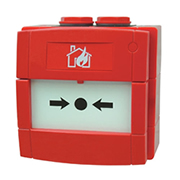
Vandalism is prevalent in many areas and not restricted to buildings accessed by the public; workers may also vandalise equipment as a means of getting back at an employer. The main areas of concern, however, are public spaces and here vandalism occurs mainly in educational buildings but licensed premises or railway undertakings also get their share. The two most common issues are tampering with equipment such as fire extinguishers or misuse of break glass call points resulting in unwanted fire alarm signals. These may lead to the fire service being summoned and are a major factor behind fire service initiatives designed to reduce unnecessary call outs.
Manual call points (MCP) usually set a panel into evacuation mode immediately as the British Standard for fire alarm systems discourages the use of any staff investigation time with MCPs; a study by the BRE trust resulted in a briefing paper "The causes of false fire alarms in buildings" that identified MCPs as the cause behind approx. one in eight unwanted alarm activations in a single building over the course of three years. The reasons given in the report were malicious activation, accidental activation or an MCP being mistaken for a door release.
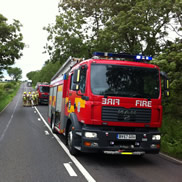
The implications of false fire alarms are wide reaching. For a business the disruption of evacuating can cost money, in educational premises it can interrupt students in research or in exam situations and may lead to complacency in real evacuation situations with potential for injury or loss of life. For fire services there are similar implications; attending false alarms means a drain on resources where fire engines are not available should a real emergency call be received. There are also costs related to loss of training and fuel etc. plus there is the increased probability that a fire engine may be involved in an accident with life changing consequences or lives lost.
Other vandalism such as tampering with firefighting equipment can range from the minor such as a security tag ripped from an extinguisher to the major such as malicious activation of one or more sprinkler heads; the latter potentially having major consequences and is often quoted as a reason not to provide sprinkler systems. The former is merely inconvenient and costly; the extinguisher is still fine but technically does not comply with the British Standards therefore must be re-inspected and re-tagged. The activation of fire extinguishers or sprinklers can result in huge clean-up costs – water fire extinguishers may cause major damage to wooden floors and dry powder can take many days of specialist cleaning to remove the powder and stop the corrosive action that may take place, especially with sensitive electronic equipment.
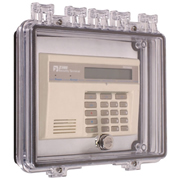
Where management is absent, other issues can arise; having carried out fire safety inspections of houses converted into flats and houses in multiple occupation that are fitted with fire detection systems, it has become clear that where tenants are left unsupervised and often with no information regarding the fire detection and alarm system, that the systems are open to abuse. A number have been found where the fire alarm panel has been smashed as tenants do not know what to do when the alarm rings and frustration has taken over; in these situations, clear instruction and effective maintenance is the key.
When a tenant is waiting outside a house at 4am for the fire service to turn up as the alarm is sounding, their frustration results in simple solutions to the problem – has anybody told them how to reset the alarm or that the fire service won't turn up unless someone dials 999? In these types of premises it is common to find smoke detectors covered up or removed to prevent the alarms sounding; the most practical solution is effective management, however, there are protective cages and covers available to prevent tampering if the situation persists.
Other items have been subject to vandalism and theft over the past few years with dry riser metal outlets being a particular target for thieves; once a single outlet is removed it is impossible to use the riser, endangering both residents and firefighters. Extreme situations have seen sprinkler systems deliberately turned off before an arsonist strikes leaving a building vulnerable.
Preventative Measures
There are a number of simple measures that can be taken to dissuade vandalism or malicious operation of fire equipment. The cheapest solution involves putting a barrier between the equipment and the potential vandal.
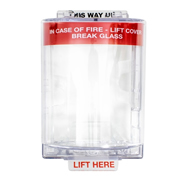
For fire alarm call points and similar break glass units there are a variety of Perspex covers that can be used. These have to be lifted in order to gain access to the break glass and if the problem persists they can be fitted with a local alarm and many of these can be retrofitted over existing call points. These have been found particularly useful in premises where there is already a decent level of management such as schools and colleges as a local alarm immediately attracts attention.
Firefighting equipment can be protected with a large range of protective equipment to prevent misuse; fire extinguisher cabinets have a dual purpose when extinguishers are located outside by giving weather protection and protecting against vandalism. Simple extinguisher covers, often with a clear vision panel, drape over the extinguisher and are fastened with Velcro. There is also a range of alarms that can be secured to the extinguishers that discourage misuse and theft; sometimes the cabinets and alarms can be combined. One of the drawbacks with alarms is that the operating key (used to silence the alarm) should be somewhere close, especially in environments such as schools where a 95 dB alarm can be disruptive – take this from someone who has inadvertently set one off while checking the extinguishers!
Simple covers are cheap and relatively effective, however, they can look a bit scruffy over time; cabinets can look 'industrial' and do not fit every environment. If extinguishers are checked locally on a monthly basis then those that are subject to the regular abuse can be targeted for protection. It should always be remembered that fire extinguishers are provided for use by nominated competent personnel who are trained in their use and that for premises subject to The Regulatory Reform (Fire Safety) Order 2005 (FSO) (Article 13) requires that a premise is "equipped with appropriate fire-fighting equipment".
Some organisations have taken the decision to remove extinguishers from public areas completely; railway undertakings decided to remove fire extinguishers from trains as they decided that they were no longer providing an overall safety benefit. The decision was reached following a qualitative risk assessment and one of the underlying reasons given was that the "industry is also experiencing a long-term reduction in the risk from a fire on board a train due to a range of factors such as introducing more flame retardant materials, more efficient removal of rubbish and the regulated public smoking ban". Their reason for undertaking the risk assessment was that fire extinguishers were often vandalised or misused and were becoming a potential source of hazard rather than a safety device.
Potential Sources of Hazard with Fire Extinguishers on Trains
- There is the potential for an increase in injury should a passenger or a train crew member go to a location expecting to find a fire extinguisher, but finds that it is missing or vandalised.
- Experience shows that fire extinguishers can be used as offensive weapons on train crew members and passengers or to vandalise the railway vehicle.
- The cost of replacing emergency equipment when it has been vandalised is high.
Other areas where fire extinguishers have sometimes been removed are within the common parts of residential blocks; the rationale behind this decision is similar to the railway example and the fact that people returning to burning flats with extinguishers may allow fire and smoke to reach the common parts plus the issue of untrained persons using firefighting equipment may put them at risk – particularly if the equipment has been previously vandalised.
Where dry riser outlets have been subject to metal thefts there have been a number of approaches mainly around security as replacing the gunmetal inlets/outlet is not possible. The latest British Standard (BS 9990:2015) advises that installed equipment should be "protected against interference and attack by thieves and vandals as far as it is possible to do so without adversely affecting operational capability." The means advised is to use security nuts or bolts and to secure exposed nut heads or threads; it is also advised that frequent management checks of the risers are carried out to ensure that they have not been subjected to vandalism or damage.
Accidental Damage
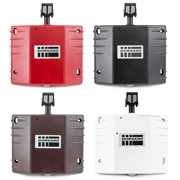
As well as deliberate and malicious damage, fire safety systems are subject to accidental damage and misuse. The most common 'accidental' misuse is the common fire door. Wedged, propped or hooked open these vital elements of the fire safety system are abused on a daily basis. The value of fire doors cannot be over emphasised but if they're open then they are useless and the solutions are often simple, especially when you have a fire detection system and can link this to electromagnetic or acoustic hold open devices.
Accidental damage can also be reduced by the use of hold open devices; particularly in hospitals and transport hubs that are subject to a lot of traffic including patient or luggage trolleys. Damage to door leaves and hinges can prevent the doors from closing effectively and forming a barrier to heat and smoke; damage to cold smoke seals can leave excessive gaps between the leaves with this sometimes being a symptom of heavy traffic.
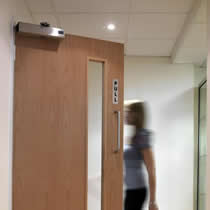
Poorly adjusted self-closing devices may also be a reason for doors not closing properly together or for closing too fast and damaging the frame or the surrounding partition. Fire doors are heavy and need the correct closer to be fitted; in addition most door closers are adjustable and the speed of closing and soft closing for the final few inches of travel can be varied. Make sure the closer is correctly adjusted to pull the door gently into the frame and overcome the latch where one is fitted. The speed of closing is also important where there are young children present who may get their fingers trapped between the door and the frame; when considering the user it is essential that the door is easily opened and 'free-swing' door closers may be considered where there are elderly, infirm or very young persons using the doors on a regular basis.
Accidental damage may also occur to break glass units and in areas where there are trolleys or fork lifts operating. Side protection should be provided to safeguard the unit and prevent accidental operation. Cages may be used on vulnerable detectors or sprinkler heads, however, when fitting it should be ensured that the cage is suitable and the head will still operate effectively – professional advice should be sought in these instances.
Summary
The article has covered some of the common issues relating to malicious and accidental damage to fire safety measures where the consequences may be an additional cost to the building management, fire service enforcement or in the worst case a threat to life. Article 17 of The Regulatory Reform (Fire Safety) Order 2005 (FSO) places a duty on the responsible person to ensure that any equipment or devices provided to protect relevant persons from the dangers of fire "are subject to a suitable system of maintenance and are maintained in an efficient state, in efficient working order and in good repair". Within the Fire Safety Order there is no express requirement to record the results of routine testing, although this would be good practice and allow the responsible person to provide evidence that testing has taken place should the need arise. A well maintained log book can go a long way to satisfying an inspecting officer that suitable systems are in place!
Fire service enforcement has seen many notices issued relating to this article. The main thrust is planned preventative maintenance of fire safety equipment and this goes beyond engaging competent persons to carry out the necessary checks on fire detection and alarm systems or emergency lighting for example. Effective management should include a planned regime of testing and maintenance as well as protection of valuable fire safety assets from damage; this is particularly relevant where fire safety engineered designs are essential for life safety.
Should you have problems with any fire safety provisions, seeking professional help will often save money and time. There is a variety of options for most situations and knowing suitable alternatives is beyond those outside of the profession but good advice from manufacturers and suppliers is always available.
If you have any questions or to find out more details about the different fire safety products mentioned in this article, please contact Safelincs on 0800 612 6537 and our friendly advisor team will be happy to help. You can also email support@safelincs.co.uk.
Reviewed: 15/04/2019 (doc:133 V1.1). Our articles are reviewed regularly. However, any changes made to standards or legislation following the review date will not have been considered. Please note that we provide abridged, easy-to-understand guidance. To make detailed decisions about your fire safety provisions, you might require further advice or need to consult the full standards and legislation.
Reviewed: 18/10/2022 (doc:133 V2.0). Our articles are reviewed regularly. However, any changes made to standards or legislation following the review date will not have been considered. Please note that we provide abridged, easy-to-understand guidance. To make detailed decisions about your fire safety provisions, you might require further advice or need to consult the full standards and legislation.




















